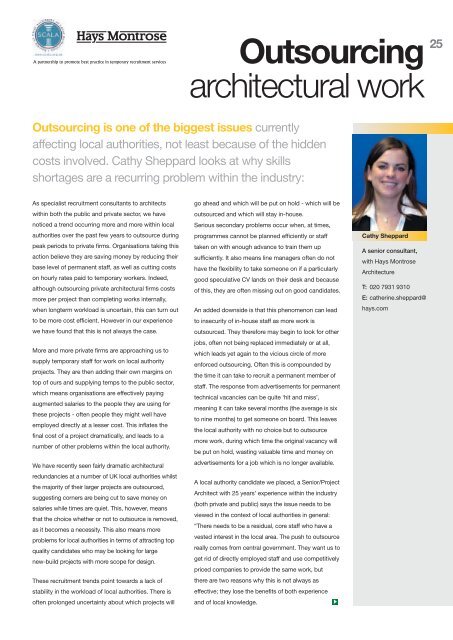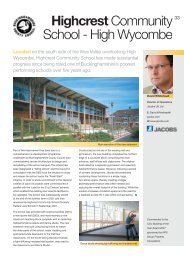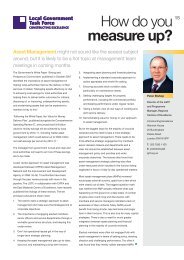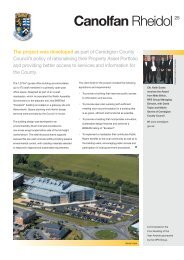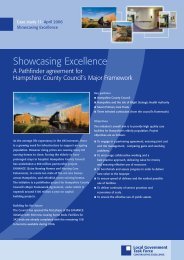outsourcing architectural work.pdf - Public Architecture.co.uk logo
outsourcing architectural work.pdf - Public Architecture.co.uk logo
outsourcing architectural work.pdf - Public Architecture.co.uk logo
You also want an ePaper? Increase the reach of your titles
YUMPU automatically turns print PDFs into web optimized ePapers that Google loves.
A partnership to promote best practice in temporary recruitment services<br />
Outsourcing<br />
<strong>architectural</strong> <strong>work</strong><br />
25<br />
Outsourcing is one of the biggest issues currently<br />
affecting local authorities, not least because of the hidden<br />
<strong>co</strong>sts involved. Cathy Sheppard looks at why skills<br />
shortages are a recurring problem within the industry:<br />
As specialist recruitment <strong>co</strong>nsultants to architects<br />
within both the public and private sector, we have<br />
noticed a trend occurring more and more within local<br />
authorities over the past few years to outsource during<br />
peak periods to private firms. Organisations taking this<br />
action believe they are saving money by reducing their<br />
base level of permanent staff, as well as cutting <strong>co</strong>sts<br />
on hourly rates paid to temporary <strong>work</strong>ers. Indeed,<br />
although <strong>outsourcing</strong> private <strong>architectural</strong> firms <strong>co</strong>sts<br />
more per project than <strong>co</strong>mpleting <strong>work</strong>s internally,<br />
when longterm <strong>work</strong>load is uncertain, this can turn out<br />
to be more <strong>co</strong>st efficient. However in our experience<br />
we have found that this is not always the case.<br />
More and more private firms are approaching us to<br />
supply temporary staff for <strong>work</strong> on local authority<br />
projects. They are then adding their own margins on<br />
top of ours and supplying temps to the public sector,<br />
which means organisations are effectively paying<br />
augmented salaries to the people they are using for<br />
these projects - often people they might well have<br />
employed directly at a lesser <strong>co</strong>st. This inflates the<br />
final <strong>co</strong>st of a project dramatically, and leads to a<br />
number of other problems within the local authority.<br />
We have recently seen fairly dramatic <strong>architectural</strong><br />
redundancies at a number of UK local authorities whilst<br />
the majority of their larger projects are outsourced,<br />
suggesting <strong>co</strong>rners are being cut to save money on<br />
salaries while times are quiet. This, however, means<br />
that the choice whether or not to outsource is removed,<br />
as it be<strong>co</strong>mes a necessity. This also means more<br />
problems for local authorities in terms of attracting top<br />
quality candidates who may be looking for large<br />
new-build projects with more s<strong>co</strong>pe for design.<br />
These recruitment trends point towards a lack of<br />
stability in the <strong>work</strong>load of local authorities. There is<br />
often prolonged uncertainty about which projects will<br />
go ahead and which will be put on hold - which will be<br />
outsourced and which will stay in-house.<br />
Serious se<strong>co</strong>ndary problems occur when, at times,<br />
programmes cannot be planned efficiently or staff<br />
taken on with enough advance to train them up<br />
sufficiently. It also means line managers often do not<br />
have the flexibility to take someone on if a particularly<br />
good speculative CV lands on their desk and because<br />
of this, they are often missing out on good candidates.<br />
An added downside is that this phenomenon can lead<br />
to insecurity of in-house staff as more <strong>work</strong> is<br />
outsourced. They therefore may begin to look for other<br />
jobs, often not being replaced immediately or at all,<br />
which leads yet again to the vicious circle of more<br />
enforced <strong>outsourcing</strong>. Often this is <strong>co</strong>mpounded by<br />
the time it can take to recruit a permanent member of<br />
staff. The response from advertisements for permanent<br />
technical vacancies can be quite ‘hit and miss’,<br />
meaning it can take several months (the average is six<br />
to nine months) to get someone on board. This leaves<br />
the local authority with no choice but to outsource<br />
more <strong>work</strong>, during which time the original vacancy will<br />
be put on hold, wasting valuable time and money on<br />
advertisements for a job which is no longer available.<br />
A local authority candidate we placed, a Senior/Project<br />
Architect with 25 years’ experience within the industry<br />
(both private and public) says the issue needs to be<br />
viewed in the <strong>co</strong>ntext of local authorities in general:<br />
“There needs to be a residual, <strong>co</strong>re staff who have a<br />
vested interest in the local area. The push to outsource<br />
really <strong>co</strong>mes from central government. They want us to<br />
get rid of directly employed staff and use <strong>co</strong>mpetitively<br />
priced <strong>co</strong>mpanies to provide the same <strong>work</strong>, but<br />
there are two reasons why this is not always as<br />
effective; they lose the benefits of both experience<br />
and of local knowledge.<br />
Cathy Sheppard<br />
A senior <strong>co</strong>nsultant,<br />
with Hays Montrose<br />
<strong>Architecture</strong><br />
T: 020 7931 9310<br />
E: catherine.sheppard@<br />
hays.<strong>co</strong>m
26 Outsourcing <strong>architectural</strong> <strong>work</strong><br />
“These recruitment<br />
trends point towards<br />
a lack of stability<br />
in the <strong>work</strong>load of<br />
local authorities.”<br />
“Private firms will look to make money rather than<br />
assess the issues particular to a local authority such as<br />
<strong>co</strong>mplex social problems and the nature of the people<br />
living there, and it is not easy to carry out what can be<br />
quite in-depth projects whilst feeling under-valued if you<br />
are an in-house staff member.” He also insists that this is<br />
not always a <strong>co</strong>st-efficient solution: “An agency will<br />
make a tender based on an initial brief from the local<br />
authority, but <strong>co</strong>sts can easily spiral when the brief is not<br />
entirely <strong>co</strong>rrect for the ensuing project. As with many<br />
plans, things change along the way and this results in<br />
the end <strong>co</strong>sts far outweighing the initial tender.”<br />
against <strong>work</strong>ing for a local authority are able to retain<br />
a CV of named private <strong>co</strong>mpanies. In addition, the<br />
projects are in essence being kept in-house, meaning<br />
there is far more <strong>co</strong>ntrol on a daily basis and better<br />
liaison with other departments within the local<br />
authority (for example with planners and surveyors)<br />
than if the projects were being dealt with by a totally<br />
separate private entity. The <strong>work</strong>load is also more<br />
flexible, in terms of delegating different stages of<br />
projects ac<strong>co</strong>rding to skill sets and peaks and troughs<br />
in other schemes, which in turn gives more flexibility in<br />
accepting and scheduling <strong>work</strong>s and deadlines.<br />
However, it is not all bad news. On a positive note,<br />
<strong>work</strong>ing with the private sector brings a great deal of<br />
diversity to a more traditionally run public sector. Private<br />
firms can <strong>co</strong>ntribute an enormous amount in the way of<br />
staff with more varied experience, and in certain areas,<br />
local authorities are <strong>work</strong>ing closely with the private<br />
sector to deliver the best of both worlds to residents:<br />
innovative, as well as <strong>co</strong>mmunity-<strong>co</strong>nscious design.<br />
Some local authorities are finding a good <strong>co</strong>mpromise<br />
by partnering with private <strong>co</strong>nsultancies. In most<br />
cases, the staff from both organisations will be<br />
<strong>work</strong>ing closely together, and often in the same<br />
building. Although at first some teething problems can<br />
occur, there are many benefits to be reaped as the two<br />
learn how best to <strong>work</strong> together.<br />
Candidates interested in public sector <strong>work</strong> are still<br />
able to have this intrinsic involvement, whereas<br />
candidates who may previously have been prejudiced<br />
In an ideal world, best value would always be taken<br />
into <strong>co</strong>nsideration. A wider variety of schemes would<br />
be kept in-house, with larger projects kept rather than<br />
partially or entirely outsourced. This would maintain<br />
the interest and job security of staff and therefore<br />
attract better candidates, keeping staff retention<br />
down. This <strong>co</strong>uld be backed up either by the use of<br />
short-term temporary staff in-house or with close<br />
partnership with a specific, carefully selected private<br />
<strong>co</strong>mpany. Additionally, because local authority<br />
<strong>co</strong>ntracts are such valuable business for private<br />
<strong>co</strong>mpanies, high quality service would be provided<br />
and good <strong>work</strong>ing relationships maintained.<br />
The key to keeping staff turnover and <strong>co</strong>sts down may<br />
well be to strike a sturdy balance between utilising the<br />
talents of <strong>co</strong>re in-house staff, and <strong>outsourcing</strong> to<br />
chosen private firms for new ideas, <strong>co</strong>st-efficient<br />
design and flexibility, thereby delivering the best<br />
possible service to local <strong>co</strong>mmunities.<br />
PLEASE DON’T FORGET!!!!<br />
To put in your schemes for the<br />
2005 SCALA Yearbook<br />
See the enclosed entry form<br />
DO IT TODAY<br />
(You know it makes sense!!!!)


